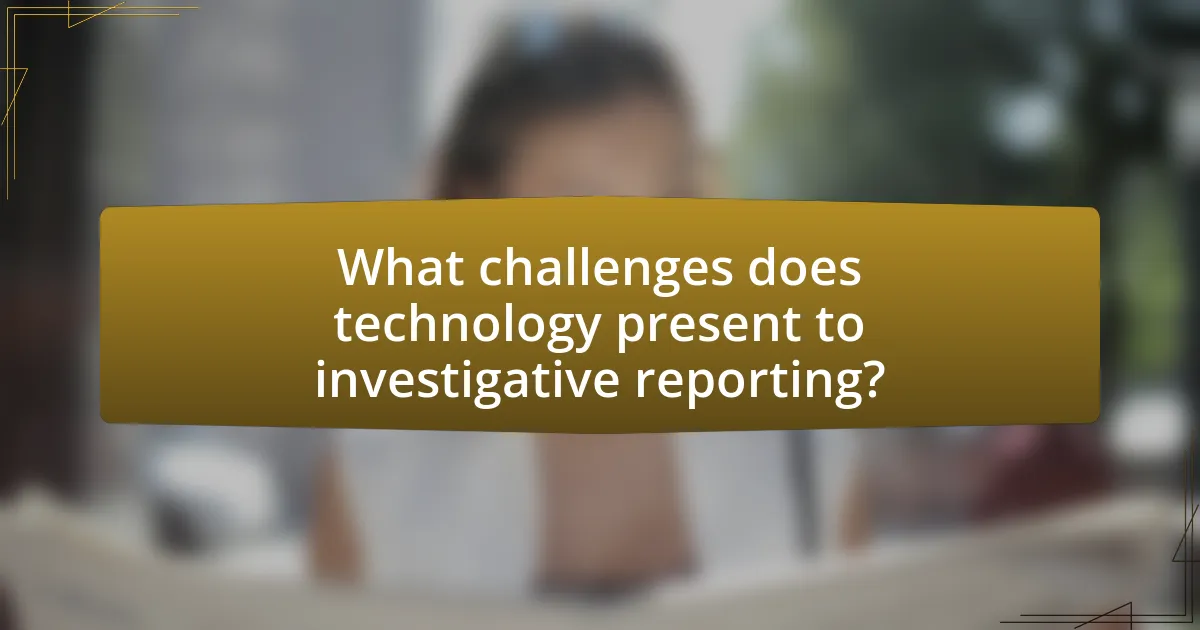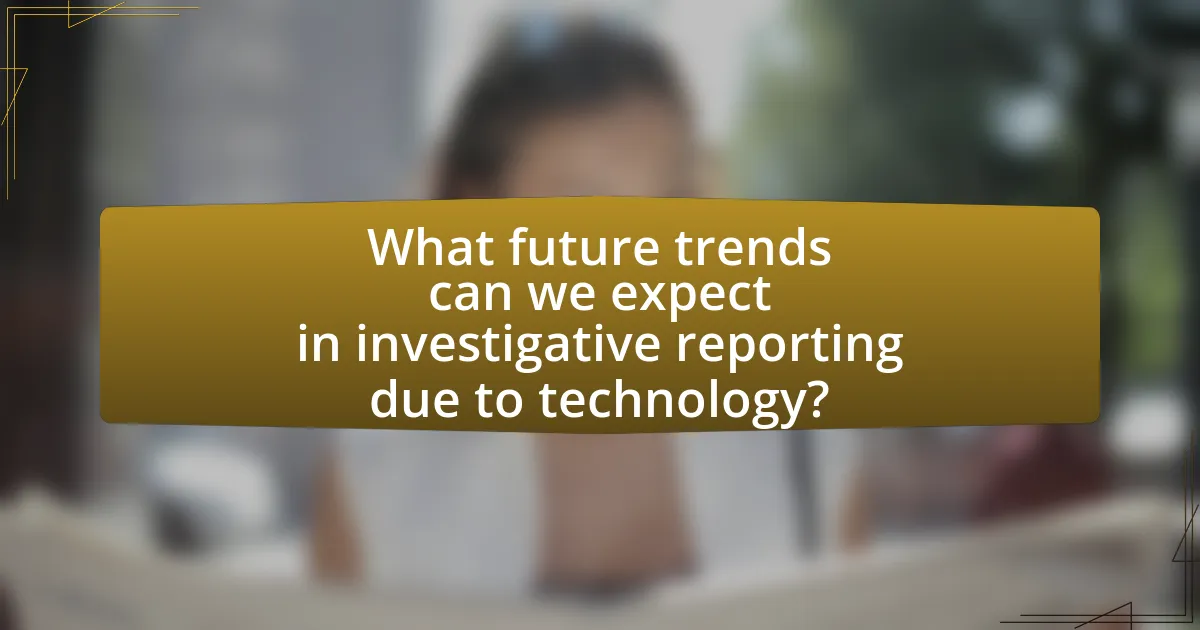The article examines how technology is transforming investigative reporting, highlighting advancements such as data analytics, artificial intelligence, and digital communication tools. These technologies enhance data analysis, improve collaboration among journalists, and expand access to information, ultimately leading to more accurate and impactful journalism. The article also addresses the challenges posed by misinformation and the need for digital security, while outlining best practices for journalists to effectively integrate technology into their work. Additionally, it explores future trends in investigative reporting, including the potential of blockchain and virtual reality to enhance transparency and storytelling.

How is Technology Reshaping Investigative Reporting?
Technology is reshaping investigative reporting by enhancing data analysis, improving communication, and expanding access to information. Advanced tools like data mining software and artificial intelligence enable journalists to analyze large datasets quickly, uncovering patterns and insights that would be difficult to detect manually. For instance, the use of machine learning algorithms allows reporters to sift through public records and social media data efficiently, leading to more comprehensive investigations. Additionally, digital platforms facilitate collaboration among journalists across the globe, enabling them to share resources and findings in real-time. The rise of open-source intelligence tools further democratizes access to information, allowing investigative reporters to gather evidence from diverse sources, including satellite imagery and public databases. These technological advancements not only streamline the investigative process but also enhance the accuracy and depth of reporting, ultimately leading to more impactful journalism.
What are the key technological advancements influencing investigative reporting?
Key technological advancements influencing investigative reporting include data analytics, artificial intelligence, and digital communication tools. Data analytics enables journalists to sift through large datasets to uncover patterns and insights, enhancing the depth of investigations. Artificial intelligence assists in automating tasks such as transcribing interviews and analyzing documents, allowing reporters to focus on critical analysis. Digital communication tools, including encrypted messaging and secure file-sharing platforms, facilitate safe collaboration among journalists and sources, protecting sensitive information. These advancements collectively improve the efficiency, accuracy, and security of investigative reporting.
How do data analytics tools enhance investigative journalism?
Data analytics tools enhance investigative journalism by enabling journalists to process and analyze large datasets efficiently, uncovering patterns and insights that would be difficult to detect manually. These tools allow for the identification of trends, correlations, and anomalies within data, which can lead to significant discoveries in investigations. For instance, the use of software like Tableau or Excel can help journalists visualize complex data, making it easier to communicate findings to the public. Additionally, data analytics can assist in verifying information and sources, thereby increasing the credibility of investigative reports. According to a study by the Tow Center for Digital Journalism, journalists who utilize data analytics are more likely to produce impactful stories that resonate with audiences, demonstrating the critical role these tools play in modern investigative reporting.
What role does artificial intelligence play in uncovering stories?
Artificial intelligence plays a crucial role in uncovering stories by analyzing vast amounts of data quickly and identifying patterns that human investigators might miss. AI algorithms can sift through public records, social media, and other digital footprints to reveal connections and insights that inform investigative reporting. For instance, tools like natural language processing can extract relevant information from unstructured text, while machine learning models can predict trends based on historical data. This capability enhances the efficiency and depth of investigations, allowing journalists to focus on storytelling rather than data collection.
Why is digital security important for investigative reporters?
Digital security is crucial for investigative reporters because it protects sensitive information and sources from unauthorized access and potential retaliation. Investigative reporters often handle confidential data and communicate with whistleblowers, making them targets for surveillance and hacking. For instance, the 2013 revelations by Edward Snowden highlighted the extent of government surveillance on journalists, underscoring the need for secure communication channels. Additionally, a report by the Committee to Protect Journalists indicates that threats to journalists’ safety have increased, emphasizing the importance of robust digital security measures to safeguard their work and personal safety.
What measures can journalists take to protect their sources?
Journalists can protect their sources by employing encryption tools for communication, using secure platforms for data storage, and maintaining confidentiality agreements. Encryption tools, such as Signal or PGP, ensure that conversations remain private and inaccessible to unauthorized parties. Secure platforms, like encrypted cloud services, safeguard sensitive documents from breaches. Confidentiality agreements legally bind journalists to protect the identity of their sources, reinforcing trust and encouraging whistleblowers to come forward. These measures are essential in an era where digital surveillance and data breaches are prevalent, as highlighted by the increasing number of reported incidents of journalist-targeted hacking.
How do encryption tools safeguard sensitive information?
Encryption tools safeguard sensitive information by converting data into a coded format that is unreadable without a decryption key. This process ensures that even if unauthorized individuals access the data, they cannot interpret it without the necessary credentials. For instance, the Advanced Encryption Standard (AES) is widely used and recognized for its effectiveness in protecting sensitive data, as it employs complex algorithms that make brute-force attacks impractical. Additionally, encryption tools often include features such as secure key management and data integrity checks, further enhancing the security of the information being protected.
How has the rise of social media impacted investigative reporting?
The rise of social media has significantly transformed investigative reporting by enhancing information dissemination and audience engagement. Social media platforms enable journalists to quickly share findings, gather public input, and crowdsource information, which can lead to more comprehensive investigations. For instance, a study by the Pew Research Center in 2021 found that 53% of journalists reported using social media to discover new story ideas, illustrating its role as a vital tool in the investigative process. Additionally, social media allows for real-time updates and interaction with audiences, fostering transparency and accountability in reporting.
What are the advantages of using social media for sourcing information?
Using social media for sourcing information offers real-time access to diverse perspectives and immediate updates on current events. This immediacy allows journalists and researchers to gather information quickly, enhancing the speed of reporting. Additionally, social media platforms facilitate direct engagement with sources, enabling the verification of facts through interactions with individuals who may have firsthand knowledge. According to a Pew Research Center study, 53% of journalists reported using social media to find sources, highlighting its significance in modern investigative reporting. Furthermore, social media’s vast reach allows for the discovery of niche communities and specialized information that may not be available through traditional media channels.
How can journalists verify information obtained from social media platforms?
Journalists can verify information obtained from social media platforms by cross-referencing the data with credible sources and utilizing fact-checking tools. This process involves checking the authenticity of the original post, examining the credibility of the user who shared the information, and corroborating the claims with established news outlets or official statements. For instance, the use of tools like Snopes or FactCheck.org can help validate the accuracy of viral claims. Additionally, journalists can analyze metadata and timestamps to assess the context and timeline of the information, ensuring that it aligns with verified events.

What challenges does technology present to investigative reporting?
Technology presents several challenges to investigative reporting, primarily including information overload, the prevalence of misinformation, and the need for advanced technical skills. Information overload occurs as journalists face an overwhelming amount of data and sources, making it difficult to discern credible information. The rise of misinformation complicates the verification process, as false narratives can spread rapidly online, undermining the integrity of investigative work. Additionally, the increasing reliance on digital tools requires reporters to possess advanced technical skills, which may not be universally available, potentially limiting the effectiveness of investigative efforts. These challenges highlight the need for journalists to adapt to a rapidly changing technological landscape while maintaining rigorous standards of accuracy and credibility.
How does misinformation affect the credibility of investigative journalism?
Misinformation significantly undermines the credibility of investigative journalism by eroding public trust and complicating the verification process. When false information circulates, it can lead audiences to question the accuracy of legitimate reporting, as seen in instances where misleading narratives overshadow factual investigations. A study by the Pew Research Center found that 64% of Americans believe that fabricated news stories cause confusion about basic facts, which directly impacts how investigative journalism is perceived. Consequently, the prevalence of misinformation creates an environment where journalists must expend additional resources to validate their findings, ultimately hindering their ability to deliver timely and accurate reports.
What strategies can journalists employ to combat misinformation?
Journalists can employ fact-checking, source verification, and audience engagement as strategies to combat misinformation. Fact-checking involves verifying claims against credible sources before publication, which helps ensure accuracy and builds trust with the audience. Source verification requires journalists to confirm the credibility of their sources, reducing the likelihood of spreading false information. Audience engagement, through social media and interactive platforms, allows journalists to educate the public about misinformation and encourage critical thinking. These strategies are supported by studies showing that fact-checking can reduce the spread of false information by up to 70%, highlighting their effectiveness in maintaining journalistic integrity.
How can technology be used to fact-check information effectively?
Technology can be used to fact-check information effectively through automated tools and algorithms that analyze data for accuracy. These tools, such as natural language processing software and machine learning models, can quickly cross-reference claims against verified databases and credible sources, significantly reducing the time required for manual fact-checking. For instance, platforms like FactCheck.org and Snopes utilize technology to verify information by employing algorithms that sift through vast amounts of data to identify discrepancies and validate claims. Additionally, browser extensions and applications can alert users to potential misinformation in real-time, enhancing public awareness and promoting informed decision-making.
What ethical considerations arise from the use of technology in reporting?
The ethical considerations arising from the use of technology in reporting include issues of privacy, accuracy, and accountability. Privacy concerns emerge when journalists utilize digital tools that may infringe on individuals’ rights to confidentiality, especially when gathering information through surveillance or data mining. Accuracy is challenged as technology can facilitate the rapid spread of misinformation, necessitating rigorous fact-checking processes to maintain journalistic integrity. Accountability becomes complex as the use of automated systems and algorithms in reporting can obscure the sources of information, making it difficult to attribute responsibility for errors or biases. These considerations highlight the need for ethical guidelines that adapt to the evolving technological landscape in journalism.
How do journalists balance transparency with the need for confidentiality?
Journalists balance transparency with the need for confidentiality by adhering to ethical guidelines that prioritize both public interest and the protection of sources. They often disclose information that is crucial for public understanding while safeguarding the identities of confidential sources to encourage whistleblowing and protect sensitive information. For instance, the Society of Professional Journalists emphasizes the importance of transparency in reporting while also recognizing the necessity of confidentiality to maintain trust and safety for sources. This dual commitment allows journalists to provide accurate information without compromising the safety of individuals who contribute to investigative reporting.
What guidelines should journalists follow when using technology in their investigations?
Journalists should follow guidelines that prioritize accuracy, transparency, and ethical considerations when using technology in their investigations. These guidelines include verifying the credibility of sources and data, ensuring the protection of sensitive information, and maintaining transparency about the methods used in their investigations. For instance, the Society of Professional Journalists emphasizes the importance of verifying information before publishing, which is crucial in an era where misinformation can spread rapidly through digital platforms. Additionally, journalists must adhere to legal standards regarding privacy and data protection, as outlined in various media ethics codes. By following these guidelines, journalists can enhance the integrity and reliability of their investigative work while leveraging technology effectively.

What future trends can we expect in investigative reporting due to technology?
Future trends in investigative reporting due to technology include increased use of artificial intelligence, data analytics, and digital collaboration tools. Artificial intelligence will enhance data processing capabilities, allowing journalists to analyze vast amounts of information quickly and identify patterns that may not be immediately visible. Data analytics will enable reporters to uncover insights from large datasets, facilitating more in-depth investigations. Additionally, digital collaboration tools will foster teamwork among journalists across different locations, streamlining the investigative process and improving the sharing of resources and findings. These trends are supported by the growing adoption of technology in journalism, as evidenced by the rise of data journalism initiatives and the integration of AI tools in newsrooms.
How will emerging technologies shape the future of investigative journalism?
Emerging technologies will significantly shape the future of investigative journalism by enhancing data analysis, improving information dissemination, and facilitating collaboration among journalists. Advanced tools such as artificial intelligence and machine learning enable journalists to analyze vast datasets quickly, uncovering patterns and insights that would be difficult to detect manually. For instance, AI-driven software can sift through public records and social media to identify leads or verify facts, thereby increasing the efficiency and accuracy of investigations. Additionally, technologies like blockchain can ensure the integrity of information by providing a secure and transparent way to track sources and document changes. Furthermore, platforms that support real-time collaboration allow journalists from different regions to work together seamlessly, sharing resources and insights that can lead to more comprehensive reporting. These advancements not only streamline the investigative process but also enhance the credibility and impact of journalistic work in an increasingly complex information landscape.
What potential does blockchain technology hold for transparency in reporting?
Blockchain technology holds significant potential for enhancing transparency in reporting by providing an immutable and decentralized ledger for data storage. This technology allows for real-time tracking of information, ensuring that all changes are recorded and verifiable, which can reduce the risk of data manipulation. For instance, in investigative reporting, journalists can utilize blockchain to verify the authenticity of sources and documents, as each entry is time-stamped and linked to previous entries, creating a clear audit trail. A study by the World Economic Forum highlights that blockchain can improve trust in information dissemination by enabling stakeholders to independently verify data without relying on a central authority. This capability fosters accountability and integrity in reporting, making it a powerful tool for journalists.
How might virtual reality change the way stories are told?
Virtual reality (VR) might change the way stories are told by enabling immersive experiences that allow audiences to engage with narratives in a three-dimensional space. This technology facilitates a deeper emotional connection, as users can explore environments and interact with characters, making the storytelling process more participatory. For instance, VR experiences like “The Invisible Man” have demonstrated how users can experience a story from multiple perspectives, enhancing empathy and understanding of complex issues. Studies indicate that immersive storytelling can increase retention of information and emotional engagement, which are critical in investigative reporting.
What skills will journalists need to thrive in a tech-driven landscape?
Journalists will need strong digital literacy, data analysis, and multimedia storytelling skills to thrive in a tech-driven landscape. Digital literacy enables journalists to navigate various online platforms and tools effectively, which is essential for sourcing information and engaging audiences. Data analysis skills allow journalists to interpret complex datasets, enhancing their ability to uncover trends and insights that inform their reporting. Additionally, multimedia storytelling skills are crucial as they enable journalists to create compelling narratives across different formats, such as video, audio, and interactive content, which are increasingly favored by audiences in the digital age. These skills are supported by the growing demand for data-driven journalism, as evidenced by the rise of organizations like ProPublica, which emphasizes investigative reporting backed by data analysis.
How can journalists adapt to the rapid pace of technological change?
Journalists can adapt to the rapid pace of technological change by continuously updating their skills and embracing new tools and platforms. This includes engaging in ongoing training programs, utilizing data journalism techniques, and leveraging social media for audience engagement. For instance, a 2021 Pew Research Center study found that 86% of journalists reported using social media to distribute their work, highlighting its importance in modern reporting. Additionally, adopting multimedia storytelling methods, such as video and podcasts, allows journalists to reach diverse audiences effectively. By integrating these strategies, journalists can remain relevant and effective in an evolving media landscape.
What training resources are available for journalists to enhance their tech skills?
Training resources available for journalists to enhance their tech skills include online courses, workshops, and specialized training programs. Organizations such as the Poynter Institute and the Knight Center for Journalism in the Americas offer courses focused on data journalism, digital storytelling, and multimedia skills. Additionally, platforms like Coursera and edX provide access to university-level courses on topics such as coding, data analysis, and social media strategies tailored for journalists. These resources are designed to equip journalists with the necessary technological competencies to adapt to the evolving landscape of investigative reporting.
What best practices should journalists follow when integrating technology into their work?
Journalists should prioritize transparency, accuracy, and ethical considerations when integrating technology into their work. Transparency involves clearly disclosing the tools and methods used in reporting, which builds trust with the audience. Accuracy is critical; journalists must verify information obtained through technology, such as data analytics or social media, to ensure reliability. Ethical considerations include respecting privacy and avoiding the misuse of technology, as highlighted by the Society of Professional Journalists’ Code of Ethics, which emphasizes the importance of minimizing harm and acting independently. By adhering to these best practices, journalists can effectively leverage technology while maintaining journalistic integrity.

Leave a Reply